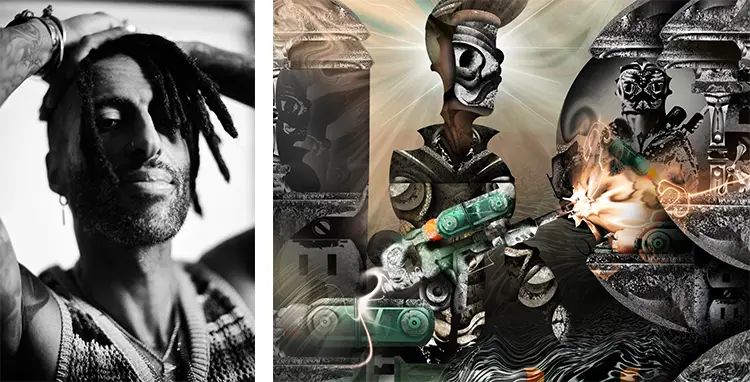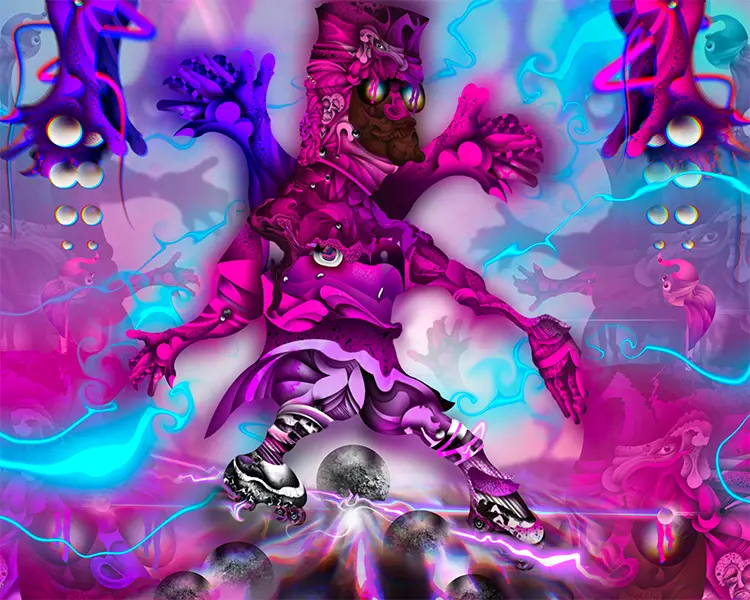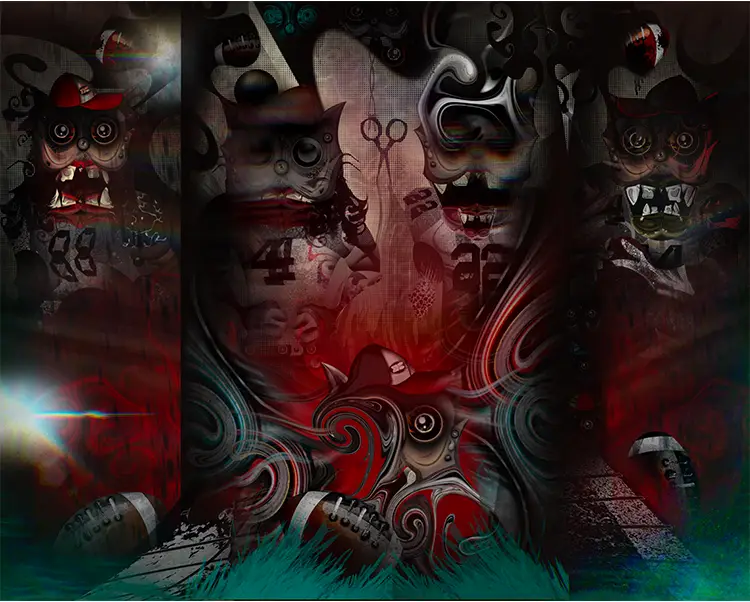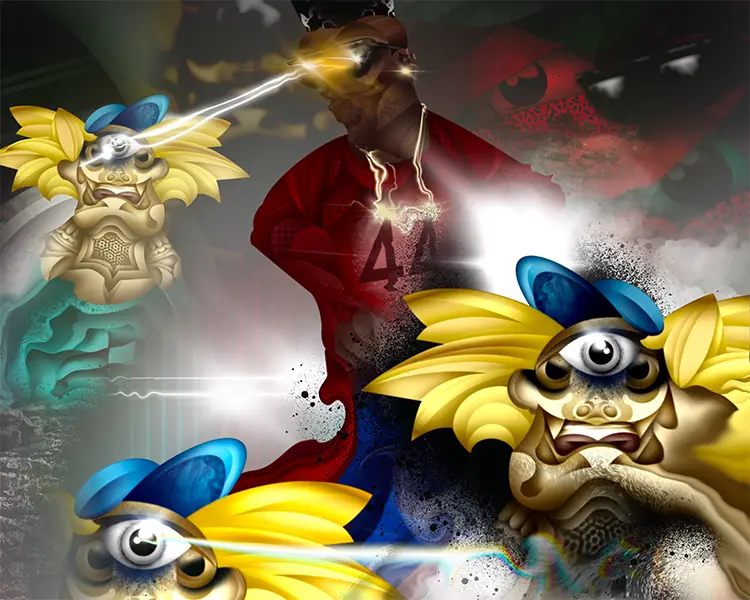“My art saved me, and it can save us all.”
Immersion Over Inspiration: An Artist Formed by Atmosphere
Creative expression was never a conscious decision for Matthew K. Addison—it was an inevitability shaped by the environment of his early life in Warwick, Rhode Island. His upbringing was steeped in music, film, and visual art, a dynamic atmosphere that encouraged exploration without formal prompting. Addison describes himself as a “pure creator,” and this identity was nurtured from the moment he could hold a pencil or hear a melody. The household soundtrack ranged from the velvet tones of Luther Vandross to the groove of Mo Town, while his father’s cinematic rituals and his brother’s visual works formed an ongoing visual and auditory workshop around him. This constant exposure saturated his senses and laid the groundwork for a multidisciplinary approach that now spans illustration, music, and acting.
Addison’s artistic journey began not with a bolt of realization, but with the slow absorption of creative forces around him. By fourth grade, he was already engaged in acting and drumming, and his passion only intensified as he moved through a school system that offered diverse environments for expression. His curiosity was not compartmentalized; it flowed across classrooms and disciplines. In science class, music class, or art class, he brought the same enthusiasm and found ways to connect knowledge to creativity. Interestingly, he used drawing as a method to internalize academic lessons—sketching conceptual visuals in his notebook margins as a form of learning. These illustrations acted as both memory anchors and self-expressions, serving as an early example of how his mind favored visual communication over linear notation.
The support from his parents was more environmental than instructional—they didn’t direct his creative energies but instead allowed them to flourish. This freedom was a gift, one that Addison credits for his expansive and unfettered artistic growth. Whether he was sketching, composing rhythms, or reciting lines for a play, his parents neither interfered nor imposed. Instead, they provided the kind of passive, enthusiastic validation that becomes foundational for a young artist. Their trust in his self-direction became the soil in which his multidisciplinary talents took root and grew strong.

Matthew K. Addison: Where Surreal Beings Meet Cosmic Soundscapes
Addison’s style can best be characterized as a swirling fusion of abstract surrealism and cosmic storytelling. He doesn’t just depict images; he births entire dimensions. His characters emerge from otherworldly places—strange, emotionally charged settings that lie somewhere between dystopia and transcendence. These creations are not just visual—they’re visceral, often screaming, sometimes glowing, and always imbued with a narrative intensity. The subjects, frequently humanoid but wildly altered, serve as reflections of his inner emotional terrain. He refers to his work as a conduit for the things he cannot say aloud—each piece functioning as a silent scream, a whisper from the soul’s darker corners illuminated by bursts of pastel or veiled in shadows.
Themes in his work fluctuate with his internal weather. The bright, playful use of color often signals moments of celebration or joy, while darker tones, distorted faces, and raw energy speak to periods of emotional struggle. Every visual choice corresponds with a specific point in his life, mapping out his emotional chronology in strokes and shades. His piece titled breakthrough is particularly emblematic of this approach. Created during his struggle with alcohol, the work features four alien-football players charging through a mossy, ominous forest. Their jersey numbers—8, 4, 22, and 44—mark the date he quit drinking: August 4, 2022, with “44” signifying his angel number, 444. The completion of breakthrough coincided with a personal turning point, illustrating how the clearing of creative blockages paralleled the clarity of newfound sobriety.
Addison’s stylistic lineage includes powerful influences—artists whose bold and often politically or emotionally provocative work resonates with him deeply. Sue Coe, Ralph Steadman, Adolf Dehn, and Brandon Boyd aren’t merely favorites; they’re catalysts. Their work doesn’t just inspire—it compels him to create. When Addison views their pieces, he senses a form of artistic genealogy, as though his characters were born from distant corners of the universes they built. This connection becomes a creative inheritance, one that informs his own art with the kind of unapologetic fervor and layered emotion that characterizes these celebrated artists.

Constructing the Vibe: Space, Silence, and the Fire Within
Addison’s workspace is an extension of his artistic vision—curated not for function alone but for emotional resonance. He surrounds himself with elements that embody balance and energy: candles flicker next to verdant houseplants, and crystals scatter across his desk like silent sentinels of intention. The air is filled with the gentle drift of incense and underscored by instrumental sounds that range from Japanese Lofi to natural ambiance. These choices are deliberate, grounding him in sensory clarity while preparing his internal space for creative flow. Earth and fire dominate his surroundings, serving not just as elements of décor but as symbolic companions in his pursuit of meaningful creation.
Time, however, is the one intruder in Addison’s otherwise tranquil setup. More than a logistical obstacle, the need to step away from his sanctuary and engage with the outside world introduces a kind of mental static that disrupts his focus. He feels most in sync with his art during the quiet of evening hours, when the world slows down and solitude envelops him. At night, he’s free from distraction and obligation, able to enter a creative zone where intuition and imagination run unbound. When interruptions do arise, he shifts his energy toward minor refinements—giving small attentions to pieces already underway. These moments act like emotional gestures, gentle affirmations that his work still lives even when the hours do not permit deep immersion.
His transition from analog to digital art began in a moment of unexpected inspiration—spotting faces in random puddles, cracks, and coffee spills. These accidental visuals sparked a new practice: capturing these forms with his phone and digitally sketching over them using only his finger. What began as spontaneous finger-painting on a touchscreen evolved into a defining medium when a friend recognized his talent and gifted him an iPad. This act of generosity elevated his work, allowing him to transition to Procreate, a digital platform where his surreal landscapes could be realized with extraordinary precision. This pairing of intuitive vision with digital capabilities unlocked a new era in Addison’s artistry, one marked by limitless potential and a heightened sense of purpose.

Matthew K. Addison: From Canvas to Cosmos and Back Again
Addison’s aspirations are not confined to the private sphere. He envisions his work on large-scale display, where it can fully inhabit the grandeur of the emotions and stories it carries. He imagines curating his own gallery shows, drenched in candlelight with cosmic hues cascading down onto oversized prints. In these dreamlike exhibitions, traditional Japanese jazz and Lofi soundscapes would underscore a sensory voyage through his creative universe. Each visitor would experience not just art, but a journey—one in which the work feels transmitted from the sky to canvas, as if falling through Addison’s imagination before arriving in physical form. The goal is not just visibility but immersion: to let the audience enter his world and feel transformed by it.
In addition to visual exhibits, Addison is laying the groundwork for animation—a logical extension of his digital creations. With a background in acting and voice performance, he envisions giving voice to his surreal characters, breathing motion and sound into beings that already feel vibrantly alive on canvas. These animations would serve as an experimental expansion of his existing work, crossing genres to create new forms of storytelling. His ability to inhabit roles vocally would lend these animated pieces an added layer of authenticity, transforming them from static images into narratives with emotional arc and depth.
Equally important to him is his children’s book project, The Light in the Forest. After meeting a children’s book publisher at The Hotel Chelsea, Addison revisited the tactile roots of his creativity—returning to sketchpads and mechanical pencils to produce work more aligned with younger audiences. Encouraged to embrace the aesthetic of his own childhood, he traded digital tools for simplicity and familiarity, resulting in a more sincere creative voice. He believes this book will reach publication and become a touchstone for children discovering themselves through its pages. For Addison, the idea that his work could illuminate a child’s sense of identity echoes the joy he once found in creation—offering a full-circle moment in a journey powered not just by imagination, but by the enduring hope that art can change lives.
To explore more of Addison’s work, visit ghost-shadows.com or follow him on Instagram @ghost_shadows_art.








